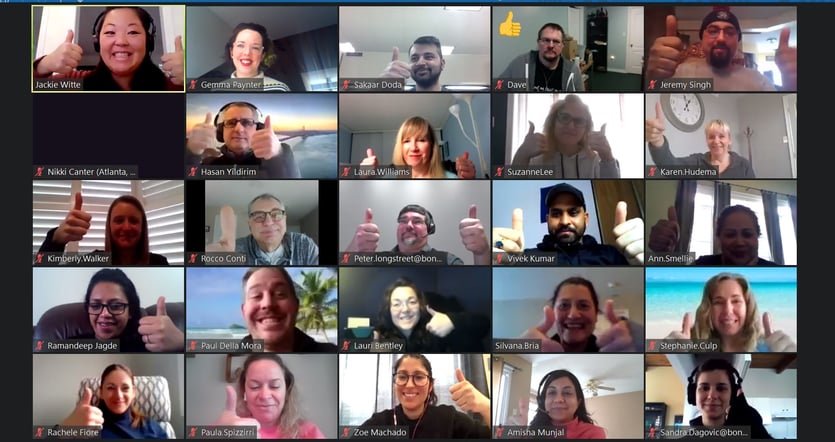Jon Fishman
COVID-19 and events: How to successfully move to virtual engagement.
Companies around the globe are rethinking the mantra, “The show must go on.”
People’s health and wellbeing are obviously top priorities for organizations during this unprecedented situation, but engaging employees, customers, partners and other stakeholders remains critical. It’s more important than ever to maintain and add opportunities to connect, even if it’s virtually. So, while there is no substitute for the impact, collaboration and effectiveness of live events, as business needs accelerate this move to digital, we’re here to help you get the most out of your virtual events.

In-person events bring a level of connection and collaboration that cannot be replicated virtually; however, over the years we have also designed and delivered highly effective digital events for clients. Based on our experience we’d like to offer some tips to help you successfully move to virtual engagement:
1. Don’t treat virtual events as simply live events broadcast over the internet—they require different thinking. It’s harder to captivate a virtual audience than an audience in a hotel ballroom, so tailor the length and substance of your content to shorter attention spans and give people multiple ways in which to interact and stay engaged. Conduct a poll, ask attendees questions and let them interact with each other. Think about production as well – it’s a live broadcast, design the experience like a show not a conference call!
2. Consider hybrid events. It shouldn’t be a binary choice between live and virtual events. A powerful and effective option is a hybrid event, in which smaller audiences gather in-person in regional locations and come together virtually as a large group. It maintains the human-to-human benefits while limiting the challenges associated with getting everyone into the same room.
3. Make it interactive. To expand on the first point, pull the audience into the conversation virtually, ensuring they’re engaged and active participants. For example, sessions can begin with an icebreaker, and be interspersed with games or contests. Insert Q&A opportunities to create engagement between presenters and audiences. Even allow attendees to pull up a virtual chair in a live chat room!
Want to learn more about how Bond can help design and produce your event? Click here.

4. Make it personal. Virtual events can allow remote participants to have a more personalized experience, choosing what content they want to consume, where they want to consume it and, crucially, when. The benefit to businesses utilizing this approach is that virtual events are easier to measure, including viewing times and real-time audience engagement.
5. Be flexible. As touched upon in the previous tip, it is important to allow audiences to participate on a schedule that works for them. Consider what content should be watched live and what content audiences can view, read or listen to on their own time. Vehicles like a series of on-demand videos and podcasts enable your attendees to engage with your message at a time when they can commit their full attention to you.
6. Choose the right technology and use it correctly. Questions of “can you hear me now?” are becoming a thing of the past, as advances in technology allow for a more reliable, accessible and higher-quality virtual experience. Internet reliability and speed have come a long way, and new virtual-event platforms let attendees get as close as possible to the real thing.
From Facebook and LinkedIn Live to Zoom to the broadcast quality that major events and conferences require, there are no shortages of available platforms to suit your needs, whether focusing on internal communications or external-facing events. But make sure you choose the right production partner and/or platform for your business needs, and ensure it is used flawlessly. Because much of this technology is so new and because there are many ways to use it, having dedicated professional support helps with working through all possible problem scenarios in advance, and also with mitigating any in-the-moment issues once live.
7. Consider the journey. Similar to live events, an attendee’s experience should span from way before the event to long afterward. An event isn’t one moment in time: it’s an experience that starts when the event is announced, how they experience their virtual arrival to communications and content that will be shared weeks and even months later. Maintaining a virtual relationship will enable you to pull the key messages through at each stage of their journey.
8. Learn from the broadcast industry. A sleek, highly produced virtual event will garner significantly more impact than having someone talk via webcam. If that’s not in the budget, there are other broadcast tips and tricks that keep audiences engaged and entertained. For example, a broadcast can be interspersed with pre-recorded segments and video chats with participants to get their feedback or reactions—much like a news broadcast that cuts to a reporter in the field.

9. Prep, prep, prep! Content for a virtual event should take substantially more planning and rehearsal than live events. Like a TV show or a commercial, virtual events are viewed as pieces of content that need to be constantly engaging and often need to live on long after the event itself, so a lot of effort should go into ensuring every moment counts.
10. Don’t lose the elements of surprise and delight. For live events, many companies go out of their way to create memorable moments, whether a celebrity drop-in, theatrical performance or a gift at the end of a long day. While the possibilities might not be as endless in the virtual-event world, small gestures like sending popcorn to the audience in advance of the virtual experience will go a long way to surprise and delight them.
11. Hire an expert. Many companies assume they can easily translate a live event to a virtual event on their own. They quickly realize that compelling content and flawless technological execution dramatically improves the experience and creates measurable business results. Working with a dedicated team of experts will ensure you get there smoothly.
While COVID-19 has been the accelerator for virtual events, we’ve seen their prevalence growing for many years thanks to other catalysts such as environmental impact, cost savings and increased personalization. We’re the first to admit that in-person events will always be more engaging and effective than virtual events. But now more than ever, we must focus on collaborating and communicating in the most effective human and digital way possible.
